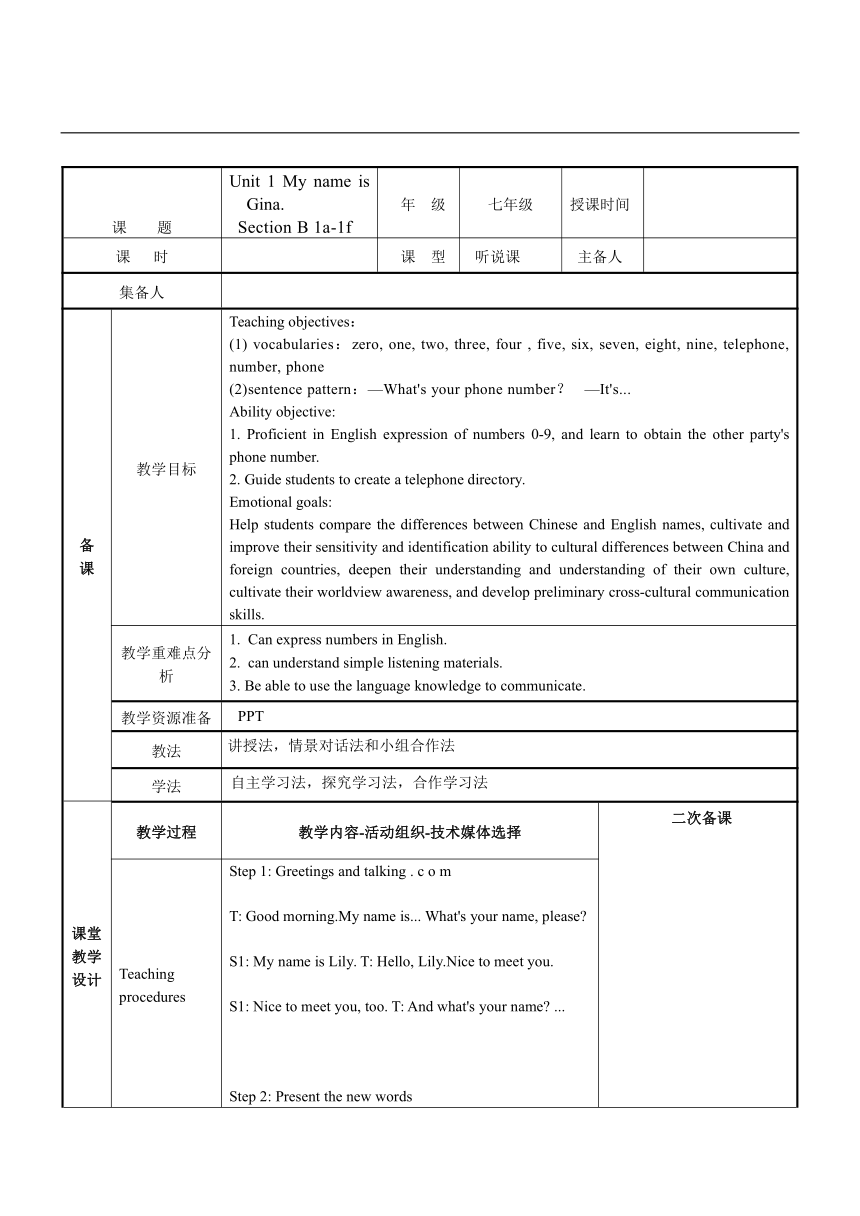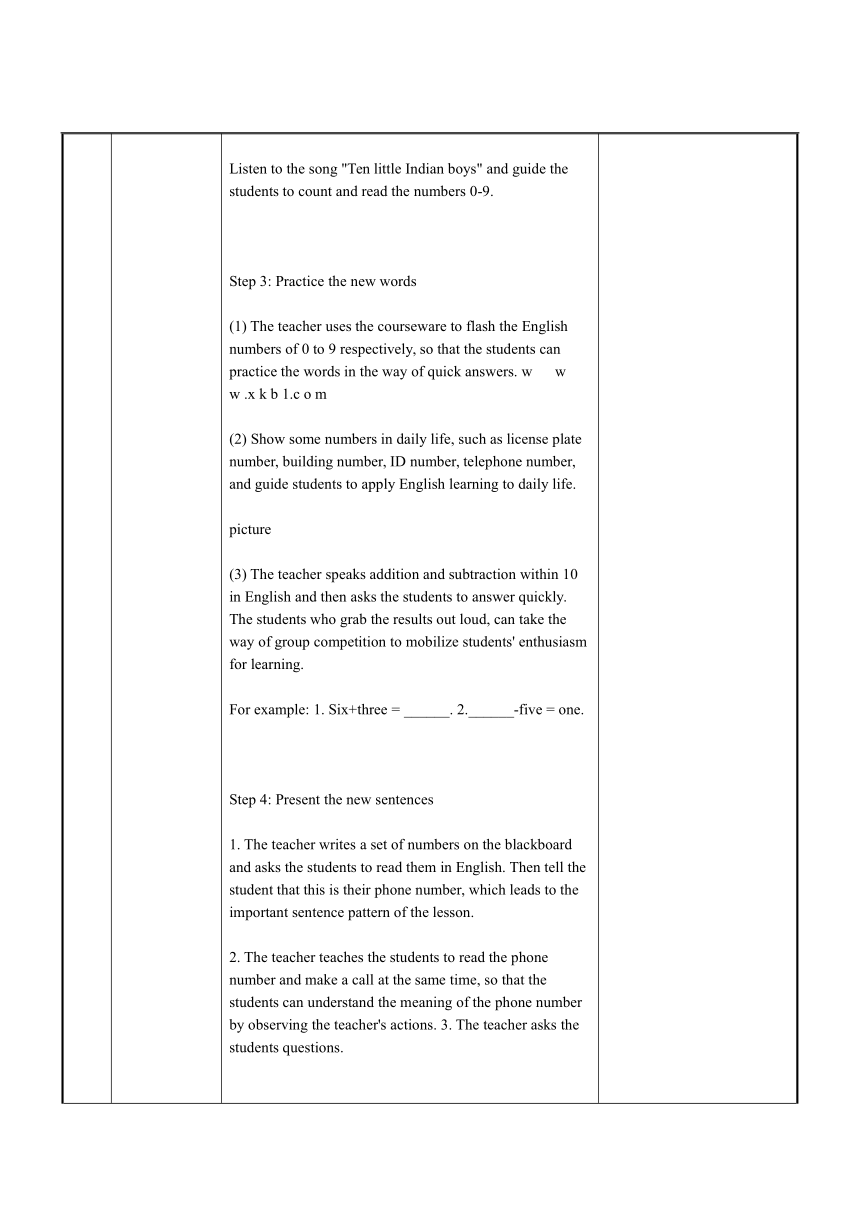七年级上册Unit 1 My name is Gina.Section B 1a-1f 全英文教案(表格式)
文档属性
| 名称 | 七年级上册Unit 1 My name is Gina.Section B 1a-1f 全英文教案(表格式) |  | |
| 格式 | docx | ||
| 文件大小 | 20.4KB | ||
| 资源类型 | 教案 | ||
| 版本资源 | 人教新目标(Go for it)版 | ||
| 科目 | 英语 | ||
| 更新时间 | 2023-07-25 15:52:00 | ||
图片预览


文档简介
课 题 Unit 1 My name is Gina. Section B 1a-1f 年 级 七年级 授课时间
课 时 课 型 听说课 主备人
集备人
备 课 教学目标 Teaching objectives: (1) vocabularies:zero, one, two, three, four , five, six, seven, eight, nine, telephone, number, phone (2)sentence pattern:—What's your phone number? —It's... Ability objective: 1. Proficient in English expression of numbers 0-9, and learn to obtain the other party's phone number. 2. Guide students to create a telephone directory. Emotional goals: Help students compare the differences between Chinese and English names, cultivate and improve their sensitivity and identification ability to cultural differences between China and foreign countries, deepen their understanding and understanding of their own culture, cultivate their worldview awareness, and develop preliminary cross-cultural communication skills.
教学重难点分析 Can express numbers in English. can understand simple listening materials. 3. Be able to use the language knowledge to communicate.
教学资源准备 PPT
教法 讲授法,情景对话法和小组合作法
学法 自主学习法,探究学习法,合作学习法
课堂教学设计 教学过程 教学内容-活动组织-技术媒体选择 二次备课
Teaching procedures Step 1: Greetings and talking . c o m T: Good morning.My name is... What's your name, please S1: My name is Lily. T: Hello, Lily.Nice to meet you. S1: Nice to meet you, too. T: And what's your name ... Step 2: Present the new words Listen to the song "Ten little Indian boys" and guide the students to count and read the numbers 0-9. Step 3: Practice the new words (1) The teacher uses the courseware to flash the English numbers of 0 to 9 respectively, so that the students can practice the words in the way of quick answers. w w w .x k b 1.c o m (2) Show some numbers in daily life, such as license plate number, building number, ID number, telephone number, and guide students to apply English learning to daily life. picture (3) The teacher speaks addition and subtraction within 10 in English and then asks the students to answer quickly. The students who grab the results out loud, can take the way of group competition to mobilize students' enthusiasm for learning. For example: 1. Six+three = ______. 2.______-five = one. Step 4: Present the new sentences 1. The teacher writes a set of numbers on the blackboard and asks the students to read them in English. Then tell the student that this is their phone number, which leads to the important sentence pattern of the lesson. 2. The teacher teaches the students to read the phone number and make a call at the same time, so that the students can understand the meaning of the phone number by observing the teacher's actions. 3. The teacher asks the students questions. Step 5: Listening (1a,1b) 1. 1a: Listen and repeat. 2. 1b: Listen and write the phone number. Step 6: Practice the new sentences What telephone number should we dial What telephone number should we dial Have the students exchange the emergency numbers they know. picture Step 7: Listening (1d,1e) 1. 1d: Listen and match the name with the phone number. (Students can read their names and phone numbers first to make the listening easier.) 2. 1e: Listen again and complete the phone number. Step 8: Summary This lesson focuses on the English expressions of numbers and how to ask for someone's phone number in English. Step 9: Homework Set up a class phone book.
作业
板书设计
教学反思
课 时 课 型 听说课 主备人
集备人
备 课 教学目标 Teaching objectives: (1) vocabularies:zero, one, two, three, four , five, six, seven, eight, nine, telephone, number, phone (2)sentence pattern:—What's your phone number? —It's... Ability objective: 1. Proficient in English expression of numbers 0-9, and learn to obtain the other party's phone number. 2. Guide students to create a telephone directory. Emotional goals: Help students compare the differences between Chinese and English names, cultivate and improve their sensitivity and identification ability to cultural differences between China and foreign countries, deepen their understanding and understanding of their own culture, cultivate their worldview awareness, and develop preliminary cross-cultural communication skills.
教学重难点分析 Can express numbers in English. can understand simple listening materials. 3. Be able to use the language knowledge to communicate.
教学资源准备 PPT
教法 讲授法,情景对话法和小组合作法
学法 自主学习法,探究学习法,合作学习法
课堂教学设计 教学过程 教学内容-活动组织-技术媒体选择 二次备课
Teaching procedures Step 1: Greetings and talking . c o m T: Good morning.My name is... What's your name, please S1: My name is Lily. T: Hello, Lily.Nice to meet you. S1: Nice to meet you, too. T: And what's your name ... Step 2: Present the new words Listen to the song "Ten little Indian boys" and guide the students to count and read the numbers 0-9. Step 3: Practice the new words (1) The teacher uses the courseware to flash the English numbers of 0 to 9 respectively, so that the students can practice the words in the way of quick answers. w w w .x k b 1.c o m (2) Show some numbers in daily life, such as license plate number, building number, ID number, telephone number, and guide students to apply English learning to daily life. picture (3) The teacher speaks addition and subtraction within 10 in English and then asks the students to answer quickly. The students who grab the results out loud, can take the way of group competition to mobilize students' enthusiasm for learning. For example: 1. Six+three = ______. 2.______-five = one. Step 4: Present the new sentences 1. The teacher writes a set of numbers on the blackboard and asks the students to read them in English. Then tell the student that this is their phone number, which leads to the important sentence pattern of the lesson. 2. The teacher teaches the students to read the phone number and make a call at the same time, so that the students can understand the meaning of the phone number by observing the teacher's actions. 3. The teacher asks the students questions. Step 5: Listening (1a,1b) 1. 1a: Listen and repeat. 2. 1b: Listen and write the phone number. Step 6: Practice the new sentences What telephone number should we dial What telephone number should we dial Have the students exchange the emergency numbers they know. picture Step 7: Listening (1d,1e) 1. 1d: Listen and match the name with the phone number. (Students can read their names and phone numbers first to make the listening easier.) 2. 1e: Listen again and complete the phone number. Step 8: Summary This lesson focuses on the English expressions of numbers and how to ask for someone's phone number in English. Step 9: Homework Set up a class phone book.
作业
板书设计
教学反思
同课章节目录
- starters 预备篇(2012秋审查)
- Unit 1 Good morning !
- Unit 2 What’s this in English?
- Unit 3 What color is it ?
- Unit 1 My name's Gina.
- Section A
- Section B
- Unit 2 This is my sister.
- Section A
- Section B
- Unit 3 Is this your pencil?
- Section A
- Section B
- Unit 4 Where's my schoolbag?
- Section A
- Section B
- Unit 5 Do you have a soccer ball?
- Section A
- Section B
- Unit 6 Do you like bananas?
- Section A
- Section B
- Unit 7 How much are these socks?
- Section A
- Section B
- Unit 8 When is your birthday?
- Section A
- Section B
- Unit 9 My favorite subject is science.
- Section A
- Section B
